As a historian of the Dominique breed, research did not end with the publication of “The American Dominique – A Treatise for the Fancier”. The search for additional information on our favorite breed’s history has continued. This includes seeking out more details on the breeders of the past. One individual that stands out in the early 1900s is Mr. A. Q. Carter.
As the years have passed and new fanciers have taken up the Dominiques, the name of Mr. A. Q. Carter is probably unknown. It was this gentleman’s efforts that prompted the American Poultry Association to realign the written standard to the breed’s characteristics. Likewise it was Mr. Carter’s winning stock from the 1913 Boston Exposition that was used as models for the 1915 Standard of Perfection. Those Dominiques are so close to the ideal that they were used in subsequent Standards for 75 years.
It is known that Mr. Carter, retiring to Jefferson, Maine in 1918 due to a lingering illness, sold his Freeport farm and Dominique stock to the father of John Gould. Mr. Gould writing about Mr. Carter stated, “He built a long poultry house and lovingly bred his Dominiques, showing them in the many poultry exhibitions of the time, as well as at all the fairs, and offering starter stock at fancy prices. Mr. Carter was a man of some means, so he conducted his poultry business on a more expensive level than other Freeporters.”
Mr. Carter was proud of his wins, but more than that, he was proud of the consistent high quality of his stock. In the 1913 National American Dominique Club booklet his advertisement stated, “My show record on Dominiques have never been equaled. But it is not the show record that always tells the tale – it is the kind of birds you actually own in your own yards. For years I have been trying to get an entire flock of Dominiques that run true throughout – not a good one here and there but all good. I have come the nearest to it this year for I got 90 per cent of good Dominique type and the other 10 per cent have gone to the butcher.”
While we know a bit about his work with Dominiques, little was known about the man – for example, the name associated with the initials was unknown. For several years this author has searched for information on Mr. Carter and only recently was forwarded information by an amateur genealogist.
The following information was found in Reverend Charles Nelson Sinnett’s 1907 work “Jacob Johnson of Harpswell, Maine and His Descendants East and West.”
When J. H. Drevenstedt raised the issue of the need for a Dominique club to return the breed to it’s former glory several influential gentlemen answered the call. They in turn wrote numerous articles on the “true old time Dominique.”
To understand why these Dominique leaders were making pleas to adhere to the Standard, it is necessary to understand the many changes that have occurred in the Dominique standards. Comparing the various editions of the Standard of Perfection it is possible to determine the points in history when the interests of specific parties prevailed upon the A.P.A. to change the Standard.
For example, the grossly inflated weights published in the 1888 Standard coincided with a desire to change the Dominique to conform to the Plymouth Rock type, in all respects except comb. This distortion of the Dominique’s type lead knowledgeable writers of the time to call for the formation of a Dominique club to preserve the breed before it was lost to crossbreeding.
The 1905 Standard of Perfection so inflamed the Dominique breeders that they began a campaign to have the Standard changed. The A.P.A., yielding to the demands of the Dominique breeders, modified the text and included the updated description in the 1910 Standard.
While the description, in the 1910 Standard, was more palatable, the art work done by Smith was not. The 1912 issue of the 1910 Standard appeared with updated cuts of the Dominique. Franklane Sewell had reworked his pictures from the 1905 Standard, as well as combining some of the better points from Smith’s pictures.
Albert Quincy Carter, born Portland, Maine, July 5, 1870; resides in Freeport, Maine, and has a summer home on Peaks Island, Portland Harbor, graduated from Portland (Me.) High School, 1886; has resided at Portland, Brunswick, Boston, Mass., etc.; traveling salesman for mill supplies; before that position was taken he had charge of a sulphite pulp and paper mill for five years at Lincoln, N.H.; writer of stories. Married, Nov 30, 1898 Izah Whitehouse, born Boston, Mass., Sept. 2, 1870, she graduated from the Norway (ME) High School, 1887, and from the Emerson School of Oratory, Boston, Mass.; the daughter of George Whitehouse of Norway, Me. And of Clara Towle of Boston, Mass.
An attempt was made to locate relatives of Mr. Carter. An unrelated individual, Paul E. Carter of Portland, Maine, was intrigued by my request and did some research of his own. From his work we learn that Mr. A. Q. Carter’s father was Captain James W. Carter, born in Nova Scotia, employed as a dealer in lobsters. Albert’s mother was Lucy Woodbury Johnson of Maine. At the time of the 1880 census, Albert had two older sisters, three younger sisters and no brothers.
I believe my correspondents have indeed located our A. Q. Carter. There is little likelihood that there were two wealthy A. Q. Carters in Freeport, Maine at the same time. Hopefully, the new clues this article contains will lead to more information on such a pivotal figure in the Dominique history.
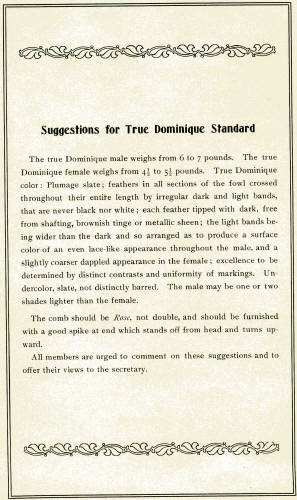
When J. H. Drevenstedt raised the issue of the need for a Dominique club to return the breed to it’s former glory several influential gentlemen answered the call. They in turn wrote numerous articles on the “true old time Dominique.”
To understand why these Dominique leaders were making pleas to adhere to the Standard, it is necessary to understand the many changes that have occurred in the Dominique standards. Comparing the various editions of the Standard of Perfection it is possible to determine the points in history when the interests of specific parties prevailed upon the A.P.A. to change the Standard.
For example, the grossly inflated weights published in the 1888 Standard coincided with a desire to change the Dominique to conform to the Plymouth Rock type, in all respects except comb. This distortion of the Dominique’s type lead knowledgeable writers of the time to call for the formation of a Dominique club to preserve the breed before it was lost to crossbreeding.
The 1905 Standard of Perfection so inflamed the Dominique breeders that they began a campaign to have the Standard changed. The A.P.A., yielding to the demands of the Dominique breeders, modified the text and included the updated description in the 1910 Standard.
While the description, in the 1910 Standard, was more palatable, the art work done by Smith was not. The 1912 issue of the 1910 Standard appeared with updated cuts of the Dominique. Franklane Sewell had reworked his pictures from the 1905 Standard, as well as combining some of the better points from Smith’s pictures.
Mr. W. H. Davenport wrote in the May 1913 Reliable Poultry Journal, “Secretary Carter writes to ask if I will send in some comments on the cuts of Dominiques in the last Standard. If he means the 1910 Standard, I certainly cannot say too much against the cuts. First, these cuts do not represent the breed in agreement with the verbal description in the book . . . . Second, the Standard ought to be better, if anything that the true birds are. This cut has a tendency to lead some men to go to cross breeding with Rocks so as to get this mongrel form, which is entirely undesirable . . . This cut is misleading to every judge who sees it, and in that way is proving a downright detriment to the breed. . .”
The overriding sentiment, from those who knew Dominiques, was that the pictures in the Standard were not lifelike and lacked the detail necessary to adequately portray the breed. Mr. Sewell, rather than take a defensive position, publicly solicited comments on what the ideal Dominique should be, then presented in the Reliable Poultry Journal, a set of cuts based on Dominiques from the A. Q. Carter flock.
To this author’s knowledge the article (above left) from the 1913 Dominique Doings is the only surviving copy of the original draft. However, a few copies of the final standard, as presented in the 1914 National Dominique Club newsletter, still exist and from the July 8 – 12, 1913 meeting of the Standard revision committee we have these notes:
“In honor of the oldest Amercian breed, the Dominique, its standard is to be a preamble or introduction. Dominique cuts rejected and new ones recommended. In both the male and female standard, the word “large” as describing size of the thigh, is stricken out. We understand Dominique men wanted changes in the color standard, and it appeared to us from representative birds shown at the last Boston show by A. Q. Carter, that the correct female feather ended with a somewhat crescentric bar. In the present Standard parallel barring is specified.”
Again there is a gap in documentation, however it is apparent that the A.P.A. approved of this change as the 1915 Standard carries a description that very closely resembles Mr. Carter’s version.
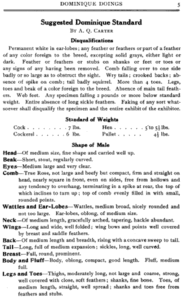
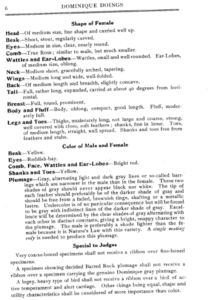
While Mr. Carter was actively promoting the club to the public and submitting recommendations to the A.P.A. on the Standard Revision, he was also exhibiting his Dominiques. If fact, the artist Franklane Sewell was so taken by Mr. Carter’s champion hen “Speckles” and his champion cockerel (no name given) at the 1913 Boston Exposition that they were selected as models for the upcoming Standard. Mr. Sewell did the initial work on the Dominique for the Standard, however; there was concern over the amount of work to be done in the complete revision and dissatisfaction with some of Sewell’s work to-date. A. O. Schilling was hired to help with the revision and he was given the task of reworking the Dominiques. His rendition of the Dominique was heralded as “magnificent”.
The Standard of Perfection issued in 1915 contained the art work of A. O. Schilling. The cut of the Dominiques is without a doubt the best that was ever done. T his artwork was of such high quality that it remained in use until the Standard of 1983 which replaced all of the half-tone black and white pictures with color plates.
The coloring of the Dominiques was based on Schilling’s artwork, though the end product is less than desirable as most of the fine detail was lost. Fortunately, the written standard remains intact and the APA has made available the current descriptions along-side the black-and-white breed pictures (commonly referred to as the Black and White Standard).
Accompanying this article are pictures of the Dominiques and the final product as shown in the APA Standard of Perfection. There are subtle differences where Mr. Schilling retouched the photographs so they would be closer to the ideal bird described in the Standard. As an example, notice that the Schilling male has longer and fuller sickles than the real bird.
While there are those that contend we should not use the Standard pictures to determine how a breed should look, it is this author’s opinion that A.Q. Carter’s description and A.O. Schilling’s interpretation are so closely aligned that in this case it is allowed.
To Mr. Albert Quincy Carter, we the Dominique fanciers owe a debt of gratitude. His writings peaked the interest of those few individuals who kept the breed alive through the lean years. His version of the breed standard was thorough, concise and most important was recognized as true to type for the breed. And finally, by immortalizing the “old type” Dominique when he donated their use to the Standard illustrators. With these actions he has helped several generations of fanciers in their pursuit of the perfect Dominique.

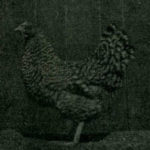
These are actual photographs of the A. Q. Carter Dominiques that won at the January 1913 Boston Exposition. The following comments were taken from the Reliable Poultry Journal.
Comments from Mr. John Robinson:
The cockerel that headed the first prize pen at Boston last winter (1912), is a fine model, with well-fitted breast and body. He has a large, well spread tail, not fully grown out in sickles. The natural pose would be to have the head and breast a trifle higher. The legs show slight crouching; would be straighter when standing or walking at freedom. The spike at the rear of the comb should be more tapered toward the blade and turned slightly upward. The color throughout shows excellent Dominique markings, remarkably regular for the breed.
“Speckle,” is the mate of the cockerel just preceding, and is also owned by the same breeder, A. Q. Carter, Freeport, Maine, secretary of the American Dominique Club. Mr Carter exhibited this fine pullet at the Boston show and was awarded first prize on her. Mr. Carter writes: “This is as good a type as I have ever seen.”
Comments from Mr. A. Q. Carter:
This male comes nearest to the general type all over. This bird has plenty of style, shape, good color and fine tail development with the exception of the great sickles, which are not fully grown. They should curve over and the tips hang on a line with the center of the body.
This is the best colored female shown and is excellent in general type. Her head should be up more and the tail carried down a trifle.
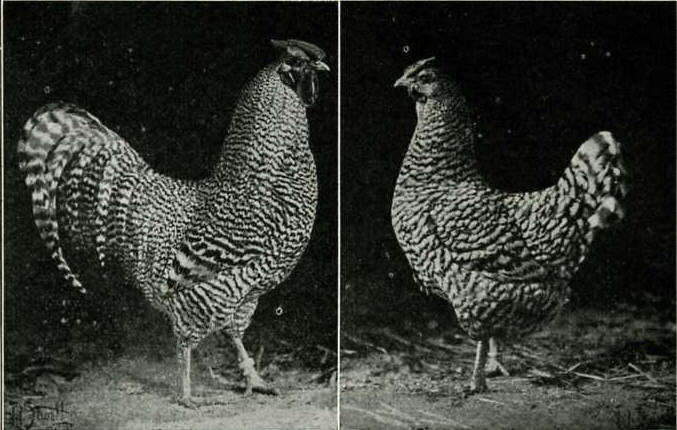
Using the A. Q. Carter Dominiques above, Franklane Sewell retouched to produce this version for the Standard committee. Writing about the results, he stated:
“I cannot do better in the interests of the Dominique progress than to set before earnest breeders of this old American race this pair of cuts made from photographs of A. Q. Carter’s first prize cock and first prize hen at the last Boston show. According to several experts, who commented on these birds, among them the experienced J. H. Drevenstedt, who judged them and awarded their prizes, the come nearest to the original, and what is today considered by Dominique breeders to be the best in the breed, of any birds seen at our leading shows in many years. Inasmuch as there is dissatisfaction on the part of Dominique breeders with the A.P.A. Standard ideals made by this writer, we request all breeders of Dominiques and those competent to judge the true type, to send to Mr. A. Q. Carter, secretary of the National American Dominique Club, Freeport, Maine, their criticisms of the ideals in the Standard, and any changes they have to suggest that will give this useful old race ideals in the next issue of the Standard that will be true to the genuine old type and that will assist in its progress.
With the exception of the portrait of old “Grandma”, no other Dominique female has impress me with her distinct type so much as Mr. Carter’s first prize hen at the last Boston show. In style and general shape she is similar to the famous old hen mentioned above. The almost gamy, ambitious carriage, that among horsemen is sometimes call “toppy,” the round head fine skull and small bone are emphasized. The wide light-colored bars of the plumage, between the second dark bars and the distinct bars that extend well across the rounded tips and give the much desired “lace like” effect, are typical in this hen and worthy to continue the fashion of the genuine old-time Dominique that experienced fanciers of this true American race are ben on preserving. The Dominique needs no introduction to veteran breeders of poultry in America. It was long ago labeled par excellent for profit on the farm.”

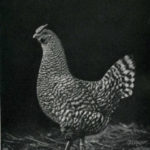
And here we have A. O. Schilling’s completed work that appeared in the Standard of Perfection for almost 70 years.
John Hrycek Jr. shared this observation: “The Standard is a guide and as a breeder you need to learn to interpret what the old master breeders were trying to explain, for the good of your breed.” -Don Schrider.
So, having reviewed the Standard and the artwork of A. O. Schilling, it would be a good time to compare all of this with a real bird. John Hrycek Jr. generously supplied a Dominique cockerel for evaluation.

John Hrycek Jr: Here is my best cockerel for this year (2014). I know he is still young but he looks off balanced. He lacks in his saddle, in the respect of width and length. The bird feels good in structure. Here is something I would dare ask here on the Dominique site. Should I look for a Hen with more cushion to improve the backs on my males? Color has not been a concern, I have too many other issues with type to be concerned about that. I have been looking ahead and have kept back some nicely marked dark hens to work on my male line.
Mark Fields: Look at the Schilling prints. There isn’t a lot of fluff. Once you have fluffy butts they are hard to get rid of. I’d rather see you work with a bird like this than to add length and softness of feather
Janice James: This bird is already fluffier than the Schilling bird. You’re right, he’s a little off balance, but I think it’s because his chest could be a bit deeper. He could grow into that. He has nice, wide tail feathers, too bad the sickles aren’t a little wider and a lot longer, but the angle is good. I haven’t found that fixing color is as simple as crossing light cocks with dark hens. I get cockerels with uneven color from that cross. But then, I haven’t found that anything is simple.
Mark Fields: Today I had a nice long discussion with an interesting gentlemen on what to do with my bantams. One of the things he reminded me over and over is type, type, type. I’m so fixated on things like color and comb that he says I’m missing what a great type bird I have. Rather than looking for a quick fix to something like color, I should be searching high and low for the best type male to put with the female and let the color fall where it may. When we then have a good base of solid “typey” birds then we can tweak the little things. Your male is probably one of the best I’ve seen posted this year. I’d hate to see you put more fluff on them (thank you Janice, I was hoping someone would chime in on that). I’d hate to see you focus on color. Rather step back and look at what a good bird you have and mate him to a good or better type female to get more good offspring. Yeah, I’m fired up. Decisions have been made at my place and I’m looking forward to next year’s breeding season Mark Fields Today I had a nice long discussion with an interesting gentlemen on what to do with my bantams. One of the things he reminded me over and over is type, type, type. I’m so fixated on things like color and comb that he says I’m missing what a great type bird I have. Rather than looking for a quick fix to something like color, I should be searching high and low for the best type male to put with the female and let the color fall where it may. When we then have a good base of solid “typey” birds then we can tweak the little things. Your male is probably one of the best I’ve seen posted this year. I’d hate to see you put more fluff on them (thank you Janice, I was hoping someone would chime in on that). I’d hate to see you focus on color. Rather step back and look at what a good bird you have and mate him to a good or better type female to get more good offspring. Yeah, I’m fired up. Decisions have been made at my place and I’m looking forward to next year’s breeding season.
John Hrycek Jr: Mark, I show no mercy with my male line. Over the last six years. I have culled hundreds of cockerels and cocks. Last winter we had family over and served Chicken Corn soup. Everyone new to the meal commented how great it tasted and I said,It should the bird took Reserve American at the Bel Air show! (judged by Tom Kane, John Womack) I have even culled the cocks at the end of the breeding season because I felt if his offspring did not make improvements then it was not worth trying to use them again. Only upwards. Years ago Mike Waski placed my Cockerel Res. American at the Fredrick show and his tail was washed just as bad as the one above. This was against a thirty something white out of a regional Plymouth Rock meet. It was like I have a permanent voice recording burned in my memory of the brief time I spent with Mike as he described his opinion of what he liked in that bird. The details of what good attributes the bird shows and how it will affect him as he gets older. I hear that recording every time I go into that old cock birds pen because he looks just like Mike said he would. But he carries that same “break” at the saddle to the base of the tail just like the cockerel above. I see birds like Fred’s that sweep their saddles up through the base of the tail giving a better curve and profile, if that helps to describe what I am after.
Heaven Roberts: The tail will keep rising and that break will get worse with age. Find hens with their legs right square under them and their backs still angled and a smooth transition to the tails. If you moved this birds legs slightly forward his chest would go up back would be angled but the tail would rise even more to balance him and your problem would be worse. I need to make a drawing I think to really describe what I am saying. I got this advice from a breeder of excellent quality Leghorns. Now they know how to sweep! Beautiful birds though you can send him to Oregon if you want.
The next step in the study of the breed standard is to review the finer points of the feathers themselves as the cuckoo pattern in the Dominique is fairly rare. This link will take you to a study of the Dominique feather.